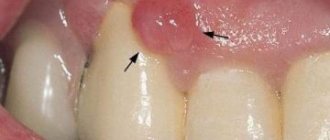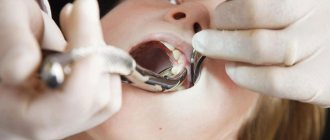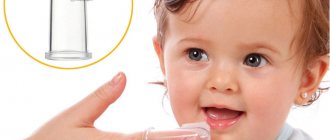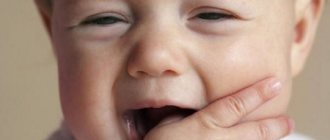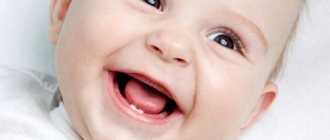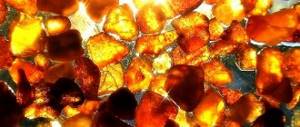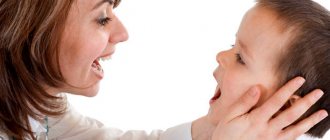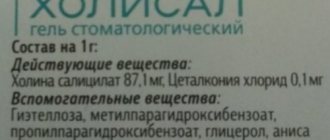What is the timing of teething?
Milk teeth erupt at a certain period in a child’s life. Not all parents know how long this lasts. It is important to determine the exact timing in order to understand what causes hyperthermia. The following main periods are distinguished:
- 5-6 months - first the lower, then the upper incisors appear, usually they erupt one by one;
- 9-11 months - upper lateral incisors;
- 12-13 months - lower lateral incisors;
- 12-16 months - chewing teeth, molars;
- 16 months - upper and lower canines;
- 18-24 months - second molars;
- 7-10 years - indigenous elements;
- 14 years and older - wisdom teeth.
Absolutely all teeth appear by 2-2.5 years. If a child's body temperature rises in the first 2 months after birth or after 3 years, this is not due to teething. With hyperthermia in the period from 4 months to 2.5 years, the indicators usually do not exceed low-grade fever.
The temperature does not rise above 38.5 degrees and lasts for a short time.
As a result of eruption, 16 teeth should appear. If parents have counted this number, this means the process has stopped. When the body temperature rises with all these teeth present, eruption is impossible. Then they look for the cause in an infectious or viral disease or other pathologies.
Is it necessary to shoot down
It is not recommended to give medications specifically to reduce fever. Elevated values indicate a natural struggle of the immune system with the problem that has arisen. The baby’s body is not yet strong enough for minor changes to occur without the appearance of characteristic symptoms. Doctors do not recommend resorting to medications if the thermometer readings do not exceed 38 degrees. The body must independently produce special substances that will help reduce the fever to normal levels.
Must be taken into account! The advice is relevant if the child feels well and there are no other manifestations of the disease. Elevated values should not be long-lasting. On the second day, in most cases they gradually decrease, but can last a full 3 days.
It is necessary to reduce the temperature if the following situations occur:
- indicators increased to 38.1 degrees;
- there are neurological problems and diseases;
- the child’s general health is poor (he is constantly sleepy, lethargic, cries a lot, eats little or not at all);
- sleep patterns are disrupted;
- there is severe pain (the baby constantly puts his mouth in his mouth).
In these cases, you need to give a syrup or suspension to reduce the fever (dosage as recommended and under the supervision of the attending physician).
When to shoot down
It is imperative to alleviate the condition of a baby who is under one year old if the indicators do not drop to normal for more than 3 days. You will also need to take action when the scale approaches 39 degrees. If an infant continues to have a fever for a long time, then its development slows down, its health worsens, and the risk of serious and even dangerous diseases increases.
It will be necessary to bring it down to acceptable values if the baby has neurological diseases. High temperatures can cause:
- development of seizures;
- blood clotting in blood vessels;
- rapid heartbeat;
- severe breathing problems.
Convulsions are associated with physiological age-related characteristics of the body. The child is not able to cope with large temperature changes. If the problem has already appeared, immediate medical attention is required. In most cases, cramps last 5-10 seconds. Consequences: dehydration and exhaustion of the body. After a child reaches the age of 3 years, with high or sudden changes in temperature, seizures do not occur in most cases.
Refusal to eat is a symptom of the onset of teething
During teething, the following behavior is considered normal:
- anxiety;
- tearfulness (but not constant);
- refusal to eat.
The baby may refuse to play with his favorite toys. Parents should be wary of other manifestations:
- long sleep;
- lethargy;
- lack of reaction to toys.
These manifestations indicate high fever. In this state, the child should not be alone. Parents should monitor their health to prevent complications. The temperature will need to be measured at intervals of 1 hour.
Fever can also be recognized by external manifestations:
- the baby's face turns red;
- lips are dry;
- a characteristic blush appears on the cheeks;
- lethargic state;
- eyes become red, moisture and shine are present;
- the skin is hot and dry, in some cases the child does not urinate for a long time.
Signs of teething in a baby
Teething occurs normally in a child. That is, it is a physiological process. If you examine the baby’s oral cavity, you can see the following main signs:
- strong secretion of saliva that flows from the child’s mouth (this is a protective reaction of the body aimed at eliminating pathogenic microorganisms in the oral cavity);
- gums swollen, hyperemic;
- refusal to eat;
- chewing foreign objects, for example, TV remote control, toys;
- disorder of stool formation accompanied by diarrhea;
- Teeth may be visible on the gums, indicating their approach.
No other foreign formations should appear in the mouth. The child becomes whiny and irritable. He constantly demands the breast or bottle for food. This calms him down. Strong crying occurs throughout the day, but intensifies at night.
If the temperature is associated with teeth, immediately after teething the low-grade fever will end. This distinguishes it from a cold. The indicator will return to normal, the child will stop crying often and being restless. The condition is often observed during the eruption of fangs. But in some children it can appear on all teeth.
Ways to reduce fever
An increase in temperature is a natural process during teething in children. You should not adjust it without special reasons. But in a critical situation, quick action is necessary.
There are two ways to normalize temperature in young children:
Medicinal method
In pediatrics, the use of two substances is allowed to normalize temperature: ibuprofen and paracetamol. Ibuprofen is effective against fever and pain. It is suitable for babies over 3 months. From the first days of life you are allowed to take paracetamol. The drug is suitable for pain relief, but is not effective at 39 °C and above. These medications are given to infants strictly as prescribed and in the exact dosage.
Preparations in the form of syrup quickly relieve fever, but produce a short-term effect. Suppositories affect the body more slowly, but the effect of their use lasts longer.
Folk remedies
Simple folk methods make it possible to reduce fever by 1–2 degrees. These include:
- Wrapping the baby in a wet diaper.
- Drying the baby with warm water. Use a wet sponge to wipe the baby's feet and hands, groin and armpits, elbows and under the knees.
- Linden blossom. Children over one year old can make tea from linden flowers. Thanks to it, sweat production increases, which leads to cooling of the body.
- Cabbage leaves that are pre-soaked in boiling water, beaten, cooled and applied to the body help.
One folk remedy is not enough. You can use it as an aid between medications.
Unacceptable methods
When a baby is teething:
- You should not allow him to chew crackers or a crust of bread. He may choke or scratch his gums.
- It is forbidden to massage the gums, cut or do other manipulations in the baby’s oral cavity, because there is a high chance of infecting it. If something bothers your parents, you should see a dentist.
- Do not use alcohol or vinegar for wiping. Evaporating, they cool the skin, and the increased temperature inside remains. Alcohol and vinegar can cause intoxication.
Teething symptoms in older children
By the age of 7-8 years, the second stage of teeth appearance begins. The milky elements fall out and are replaced by radical structures. This process is tolerated by children much easier than in infancy. There is practically no pain syndrome, since there is already a hole in the gum and it is not damaged. But the following discomfort signs may develop:
- aching sensation in the mouth;
- severe itching in the gums;
- insomnia or taking a long time to fall asleep at night;
- lack of concentration, absent-mindedness;
- swelling of the cheek;
- in rare cases, a slight rise in temperature to 37-37.5 degrees.
Negative signs in the child quickly disappear. But it is important to ensure that infection does not penetrate into the hole where the baby tooth used to be. If a child has a tendency to pathology, it is recommended to rinse the mouth with furatsilin, chamomile, and other herbal antiseptics. Most products not only have disinfectant properties, but also relieve inflammation.
Typically, the filling of the oral cavity with radical elements occurs closer to 10 years. In some children the process may occur delayed. But most cases end quickly and painlessly.
Signs of pathologies in the mouth
More often in infants, increased salivation and low-grade fever mean teething. This is not always true. If the following symptoms appear, it is recommended to look for the disease:
- coating on the tongue (gastritis, colitis);
- white growths on the gums (stomatitis);
- bad breath (pathologies of the gastrointestinal tract, tonsils, adenoids);
- small or large wounds caused by mechanical damage, infection;
- bleeding of soft tissues;
- severe swelling of the cheek caused by the accumulation of exudate in the inner part of the tissue (for example, with flux).
Symptoms develop due to bacterial or fungal infection. Children at this age often chew on foreign objects and toys. If they have sharp edges, there is a high risk of mechanical damage to the gums.
If you are unsure of the cause of the child’s negative condition, it is better to consult a pediatrician.
It is important to identify the infectious process in a timely manner so that bacterial or fungal infection does not spread throughout the internal tissues. This is fraught not only with damage to the mucous membrane, but also with the development of purulent formations. Pathologies are more difficult to treat and are more difficult for the child to tolerate.
Additional methods to help get rid of hyperthermia
The anxious period during the eruption of a particular tooth should not exceed more than a week, otherwise the baby’s immunity will begin to decline even more, and the risk of infection will become higher. It is in the power of parents to alleviate the condition of the baby. It is not necessary to use only medications.
What can be done to reduce the temperature and normalize the condition? Give your baby plenty of water and various fruit drinks so as not to cause dehydration. Ventilate the room in which the child is located (take him out of the room first); the air temperature should be between 17–20°C. Humidify the indoor air using special humidifiers or wet cleaning.
Let your baby's skin breathe. To do this, you need to remove all clothing that interferes with normal heat exchange. The child can be undressed down to diapers (panties) and a T-shirt. Breastfed babies need to be put to the breast more often.
Signs of wisdom teeth erupting
Teething does not always happen in children. When it comes to wisdom teeth, the age is determined from 14 years and older. Usually the process is completed by 30-35 years. The molars are large in size and slowly move up the soft tissues. This causes the following negative symptoms in patients:
- increase in body temperature up to 38 degrees;
- an increase in body temperature above 38 degrees, if the eruption of wisdom teeth is accompanied by suppuration of the soft tissues due to the proliferation of infection;
- inability to chew food because the tissues are swollen;
- extensive swelling of the cheek;
- the lesion hurts at any time of the day, but the discomfort intensifies after eating food due to prolonged chewing;
- runny nose caused by the accumulation of immune cells in the nasopharynx during inflammation in the oral cavity.
Most wisdom teeth erupt very slowly. Then the inflammation develops less, the swelling is minimal. If the process occurs at a rapid speed, acute pain occurs. Wisdom teeth are dangerous not only because of their eruption, but also because of the tendency of this area to form gum pockets filled with purulent exudate. This happens when food gets under the gum.
In rare cases, molar eruption may be pathological. For example, the molar is not turned up, but to the side. It damages the adjacent tooth as it grows. It is recommended to remove such elements in a timely manner. They are detected using radiography.
Diagnosis confirmation
Parents will not always be able to understand why their child’s temperature has risen. Then it is recommended to consult a pediatrician to confirm the diagnosis. At an early stage, pathologies are easier to eliminate. Hyperthermia does not always occur against the background of teething.
When it comes to small children whose baby teeth are just developing, X-rays are not taken.
Excessive radiation negatively affects health. You just need to get examined by a pediatrician or dentist. If the temperature persists for more than 3 days, other negative symptoms occur, a smear is taken to determine the presence or absence of infection. When the doctor cannot accurately determine the cause, the condition continues to worsen, an x-ray is prescribed.
For older children, the range of diagnostic procedures has been expanded. For their age, acute pain when the root elements occur is not typical. The following diagnostics are recommended:
- examination by a pediatrician or dentist;
- radiography of the jaws;
- bacterial culture of a nasopharyngeal swab;
- opening of swollen gums if internal suppuration is suspected.
After completing the diagnosis, the correct treatment is prescribed. Thanks to the examination, the cause is accurately understood without giving the child unnecessary medications. If the discomfort and low-grade fever persist after completion of therapy, laboratory and instrumental examinations are repeated.
What to do when the temperature rises?
If a child develops hyperthermia due to teething, no specific treatment is required. The condition passes quickly, but many children have a hard time bearing it. If only a slight low-grade fever develops, antipyretics are not used.
In rare cases, the temperature may rise above 38 degrees. Only then do doctors allow the use of antipyretic drugs. The following medications are used:
- Nurofen is a non-steroidal anti-inflammatory drug based on ibuprofen, which simultaneously reduces body temperature, eliminates inflammation and pain;
- Paracetamol is an antipyretic with much fewer side effects than NSAIDs.
Most medications that eliminate teething hyperthermia contain ibuprofen or paracetamol. They may differ in name, but the active substance remains the same. It is important to choose the right shape. For children under 3 years of age, a syrup form is recommended. After this age, tablets are used. Injections are not used during teething.
Antipyretics are used in a short course. Excessively long use leads to adverse reactions. This is especially true for NSAIDs, they negatively affect the gastrointestinal tract.
What to shoot down
Heat up to 39-40 degrees is especially dangerous for babies under one year old. Their life support organs are not fully formed. Hyperthermia causes convulsions, increased heart rate, and breathing problems.
The brain of newborn babies and infants is not yet mature for sudden changes in body temperature. For this reason, convulsive syndrome occurs. It is more common in children with central nervous system disorders. It lasts a few seconds and is not dangerous to the child’s life if you give antipyretics in time and monitor the thermometer readings. At one year of age, and especially after 3 years, seizures are rare in children.
Hyperthermia leads to dehydration and exhaustion of the body. These consequences can be easily avoided by following a drinking and rest regime. In this case, the teeth will cut easier.
| Medicine | Release form | How it works | Efficiency | For what age |
| Paracetamol | Tablets, syrup | Reduces temperature quickly, relieves pain and inflammation | In extreme heat 39-40°C it is ineffective | From 1 month |
| Tsefekon | Candles | Analgesic, antipyretic | Used successfully at high temperatures | From 3 months |
| Efferalgan | Candles, syrup, tablets | Reduces temperature, relieves pain | Effective for relieving fever up to 39 degrees, causes diarrhea when using suppositories | From 1 month |
| Ibuprofen | Syrup, tablets | Acts quickly and relieves intense heat | The effect lasts at least 5 hours, weak analgesic. Not recommended for children with kidney or liver diseases | From 3 months |
| Panadol | Syrup | Analgesic, antipyretic | Effective antipyretic, analgesic, does not relieve inflammation | From 3 months |
| Nurofen | Syrup | Relieves intense heat and pain | Effective analgesic, antipyretic agent. Cannot be combined with other analgesics | From 3 months. For children weighing more than 6 kilograms |
| Ibufen | Tablets, suspension, syrup | Has anti-inflammatory, antipyretic effect. Relieves pain | Acts quickly, maximum effect lasts at least 5-6 hours | From 3 months |
To increase the effectiveness of the medication, alternate them. Suppositories and suspensions are better suited for infants. They do not contain dyes or lactose, which often cause allergic reactions.
The tablets need to be crushed and dissolved in water, you can add a little honey.
This way the baby will swallow the medicine with pleasure.
How to help with teething?
Measures of treatment and assistance with teething depend on the age of the patient. If it is a baby, the condition is difficult to tolerate. Many drugs are not available for this group of patients. For adult children, completely different therapy is prescribed. All methods are listed in the table.
| Method of therapy | Young children | Older children or adults |
| Painkillers | Anesthetic gels applied to the gums. For example, Kalgel, Kamistad. They act locally, so the risk of side effects is reduced | Topical gel applied to the gums. If the pain is unbearable, take a non-opioid analgesic. NSAIDs relieve pain, fever, inflammation (Ibuprofen) |
| Herbal decoctions | The method is rarely used; it is impossible to predict allergies. Use chamomile or calendula lotions. They have a disinfecting, anti-inflammatory effect | Rinse your mouth with a decoction of chamomile, calendula, celandine, and oak bark. |
| Rinse with antiseptics | Not applicable | Furacilin, Chlorhexidine. Destroy pathogenic microorganisms in the oral cavity, preventing infection of the socket |
| Doctor's help | Not used, teeth erupt on their own | If eruption is difficult, use a scalpel incision in the gums. The method is used for purulent infection |
If a runny nose, diarrhea, or hyperthermia persists after the tooth appears, look for another cause. Conditions require different treatments. For example, using antibiotics.
How to bring down the temperature?
There are many ways to reduce a child's fever without the use of medications. This should be done if the child does not tolerate even low temperatures (up to 38). Here's what you can do:
drink plenty of fluids (plain still water); wiping with a damp towel
Pay attention to two things: You need to wipe your entire body. Do not use liquids containing alcohol for this. While cooling the skin, they do not help relieve fever; on the contrary, the temperature may increase due to the fact that the pores close due to the action of alcohol. a cloth soaked in cool water and placed on the forehead
It is recommended to change such a cloth as needed; chamomile decoction. Pour boiling water over 4 grams of dry raw materials. Time must pass during which the tea infuses, and after straining it will turn into a wonderful remedy that will help reduce inflammation and lower fever; tea made from linden flowers has a diaphoretic effect, and this leads to a decrease in temperature.
It is better not to give any antipyretic drugs without consulting your doctor. If such a need arises, you can use ibuprofen or paracetamol, provided that the baby does not have an allergic reaction to these medications.
Remember: by using medications during mild fever, you make the child worse. An organism that is deprived of the ability to independently cope with various pathogenic bacteria can do a bad job in adult life: a serious decrease in immunity in an adult will lead to more frequent illnesses.
There is one unspoken rule: the younger the child, the less high his temperature needs to be brought down. For example, for a three-month-old baby this bar is at 38, while for older children - 7-8 months - you can wait until 38.5.
Chamomile is a harmless folk remedy that can be used in small quantities without medical advice. If you want to give your baby a decoction of any herbs and are sure that in this situation it will help alleviate his condition, consult your pediatrician.
Why is teething accompanied by hyperthermia?
When a tooth erupts, an inflammatory reaction occurs at the site of gum damage. Immune cells accumulate in this area to protect this part of the mouth from bacteria and fungi. This forms swelling. Chewing becomes difficult and appetite disappears.
Severe pain, the influence of the immune system, and constant lack of sleep in the child lead to an increase in body temperature. It can last 1-3 days. But this is where it always ends and goes back to normal. This distinguishes it from pathologies that form in the oral cavity.
Low-grade fever (value 37-37.5 degrees) is not eliminated in any condition. It means that the body is fighting against some damaging factor, therefore it activates all its forces. Even if the condition is caused by a viral or bacterial infection, antipyretics are not recommended. The same applies to the appearance of new dental elements.
If hyperthermia rises above 38 degrees, it is important to determine the true cause of the condition. When it comes to teeth, use only an antipyretic. If a bacterial infection is present, local or systemic antibiotics are additionally prescribed.
How long does the high temperature last?
This largely depends on at what stage the increase appeared. For some, it appears at the time of gum eruption, while for others it occurs already at the stage of the tooth emerging from the jawbone, so it persists much longer.
In average cases, the picture persists for three days. Under some circumstances, hyperthermia lasts much longer and is characterized by very high values:
- The eruption of several teeth at the same time, which aggravates all symptoms.
- Pathogenic microorganisms develop in the gum tissue, causing severe inflammation. For this reason, complications such as swelling of the oral cavity, hemorrhages of the mucous membrane, etc. may develop. Infection most often results from injuries to the mucous membrane, which are often observed at the stage of teething.
- Progression of any disease not related to teething. Rhinitis, stomatitis, bronchitis and other pathologies are often attributed to teeth.
If hyperthermia lasts longer than three days, then parents should consult a pediatrician to prevent possible illnesses.
It also happens that the temperature lasts longer, rises much higher and is not brought down by antipyretics. When this happens, the child must call a doctor, since any complication can occur.
As a rule, a child’s temperature during teething does not last more than two to three days - during this time the body copes with inflammation
To bring down the temperature and save the baby from additional suffering, which he already suffers a lot during teething, doctors recommend antipyretics. Among modern medicines these are:
- paracetamol;
- ibuprofen;
- nimesulide;
- seduxen.
Children's paracetamol is considered one of the best antipyretic drugs; it will help quickly relieve fever and improve the child's condition.
Preparations based on paracetamol (acetomifene) can be used from birth - these are Panadol, Efferalgan, Teylenol, Calpol, Cefekon D. These drugs are considered to be the safest. When the temperature rises from 38.5 degrees, the child is given 1 dose of medication or a rectal suppository with paracetamol is placed. The effect appears within 20-30 minutes - the temperature drops by 1-2 degrees and the baby’s general condition improves.
Ibuprofen-based drugs (Ibuprofen and Nurofen) are prescribed when paracetamol products are not effective. Since their effect is stronger, they are allowed for children only after 1 year.
Preparations based on nimesulide are even more toxic, although they have a better antipyretic effect. Nice, Nemulid or Nimesil should not be used for more than 3 days and should not be prescribed independently.
Seduxen does not bring down the temperature, but it is often prescribed in parallel with antipyretic drugs - this is a weak sedative drug that is given to children ¼ tablet in cases where the child is overexcited, has extremely painful teething, sleeps and eats poorly (or cannot eat and sleep at all) ).
When the temperature and pain rise, many immediately remember aspirin and analgin. Here you need to remember well that these medications are not used to treat children - they are very toxic and have many side effects.
An elevated temperature does not always indicate teething - sometimes this symptom is associated with disturbances in the functioning of the body. In order not to stuff your child with pills in vain, you need to consult a doctor

